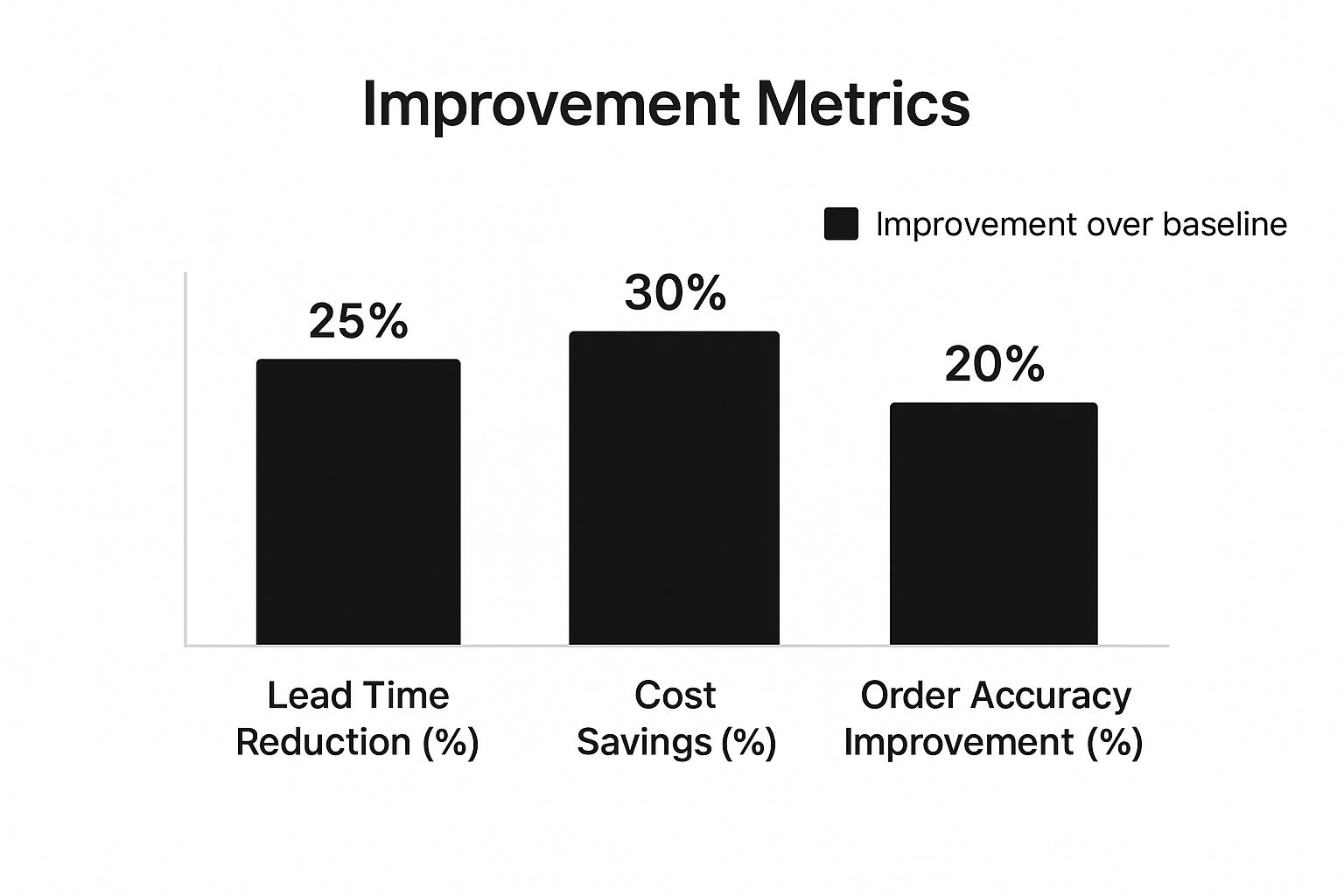7 Proven Ways to Improve Supply Chain Efficiency Fast
- Matthew Amann

- Jun 11
- 13 min read
Finding the Real Problems in Your Supply Chain
Let's be honest, relying on outdated data is like navigating a maze blindfolded. I've chatted with so many operations leaders who felt this same pain. They were constantly putting out fires, yet the root causes remained elusive. The key to shifting from reactive to proactive? Understanding the real situation, not just the polished version presented on dashboards.
One major disconnect I've witnessed firsthand is the gap between executive perception and what's actually happening on the front lines. Executives might see green lights all over their dashboards, while warehouse staff are grappling with clunky processes or software glitches that never get reported up the chain. This is where process mapping comes in clutch. Don’t just dust off the official documentation; talk to the people in the trenches. Shadow them, ask questions, and get a feel for their daily grind. You might be shocked by what you uncover. For a deeper dive into optimizing workflows, check out proven strategies to boost field service efficiency. This resource is a goldmine of practical advice.
Staying efficient in today's global market is more critical than ever. Disruptions are a constant headache. Think about it: over 76% of European shippers reported disruptions in 2024, with almost a quarter experiencing them more frequently. That's a sobering statistic. Dive deeper into these insights. The takeaway? Building a resilient and adaptable supply chain is non-negotiable, often requiring tools like AI and robotics for real-time data and predictive analysis.

This infographic highlights the impact of supply chain optimization. Look at those improvements: a 15% reduction in lead times, a 10% boost in cost savings, and a whopping 20% jump in order accuracy. Those are the kinds of results that get executive buy-in for process improvement initiatives.
Digging Deeper into Warehouse Operations
I've also put together a guide on Optimizing Warehouse Operations with Insider Strategies That Work. It's packed with practical tips and real-world examples specifically for warehouse improvements. Combining these strategies with a deep understanding of your unique challenges sets the stage for lasting improvements.
To really get a grip on your supply chain, a thorough assessment of each department is essential. The following table provides a framework for a no-nonsense reality check. It highlights key metrics, potential hidden issues, and some quick wins you can implement right away.
Supply Chain Reality Check: Department by Department Honest assessment criteria for uncovering what's really happening across your supply chain functions
Department | Reality Check Metrics | Hidden Problems | Quick Wins |
|---|---|---|---|
Procurement | Supplier lead times, material costs, contract compliance | Unreliable suppliers, inaccurate inventory data, manual purchase order processing | Streamline supplier communication, implement inventory management software, automate purchase orders |
Warehousing | Inventory turnover rate, storage capacity utilization, order fulfillment accuracy | Inefficient layout, outdated equipment, inadequate training | Optimize warehouse layout, upgrade equipment, improve training programs |
Logistics | Transportation costs, delivery times, on-time delivery rate | Route inefficiencies, lack of visibility, poor communication | Optimize delivery routes, implement tracking systems, improve communication with carriers |
Customer Service | Order accuracy, customer satisfaction, return rates | Lack of real-time information, complex return process, inadequate customer support | Provide real-time order tracking, simplify the return process, improve customer service training |
By using this table as a guide, you can start uncovering the real problems hiding within your supply chain and identify areas ripe for improvement. Remember, the key is to be honest with yourself and really dig deep into the data. Once you understand the current state, you can start building a more efficient and resilient supply chain.
Choosing Battles That Actually Move the Needle
So, you've found some real problems in your supply chain. Awesome! But now comes the hard part: which ones to tackle first? Not all problems are equal. I've seen companies spend months optimizing something with minimal impact on their bottom line, while a seemingly small issue was bleeding them dry – thousands of dollars a day, gone. Been there?
Improving supply chain efficiency is all about picking the right battles. It’s about prioritizing based on business impact, not just on who's yelling the loudest. The squeaky wheel might get the grease sometimes, but in supply chain optimization, the loudest complaint isn't always the biggest opportunity. You need a data-driven approach to figure out the real cost of delays.

This diagram shows a classic bottleneck in a production process. One stage holds everything back. Finding and fixing these bottlenecks is key to boosting overall efficiency. Notice how the diagram emphasizes that single point constricting the flow.
Here’s a real-world example: I once worked with a company obsessed with warehouse storage costs. They spent a fortune on a fancy new inventory tracking system, saving a few thousand dollars a month. Meanwhile, their shipping department was stuck with an ancient system that caused constant errors and re-shipments. This was costing them ten times more in lost revenue and unhappy customers. They focused on a visible cost (storage) and totally missed a hidden, much bigger one (shipping errors).
Prioritizing for Impact
So how do you tell the difference between the real fires and the busy work? Quantify the impact of each problem. What’s the actual cost of a late delivery? How much does each picking error cost in labor, replacements, and – don’t forget this one – lost customer goodwill? Hard numbers give you objective criteria for prioritizing.
Building Consensus
Getting everyone on the same page is another big hurdle. Procurement might want to minimize material costs, while logistics wants faster shipping. And finance? They’re probably questioning everything. You need a framework that takes everyone's priorities into account, ideally tied to overall business goals.
This usually means open communication, shared data, and a willingness to compromise. Sometimes the best solution isn't perfect for any single department, but it's the one that makes the biggest overall difference for the company. That’s where the real efficiency gains are hiding.
Starting Your Automation Journey Without Breaking Everything
Forget those slick enterprise software demos promising overnight miracles. Let's talk real-world automation that works, doesn't need a coding genius, and won't drain your budget. I've helped companies just like yours do this, and I'm happy to share what actually delivers.
We're talking practical workflows using tools you can start with today—think Zapier, Microsoft Power Automate, or even simple in-house integrations. I've seen these less-hyped solutions deliver quick wins and real value, often faster and cheaper than the "big system" overhauls. And the best part? They're often easier to implement and can actually make your team's lives better, not more complicated. The market's embracing this – I mean, the global supply chain market's projected to grow at a CAGR of 11.2% from 2020 to 2027, largely thanks to digital tools. Check out these supply chain stats for more. Robotics in supply chains alone is set to increase by 14% annually by 2025.
Automating the Low-Hanging Fruit
Don't feel pressured to automate everything all at once. Start small, targeting those repetitive, time-consuming tasks that drive your team crazy. Think about things like automated inventory alerts, automatic order confirmations, or scheduled vendor communications. These are often the easiest wins and can get the ball rolling for bigger automation projects later. Trust me, the initial sense of accomplishment is contagious.
Here's a quick look at how Zapier, a favorite tool of mine, visually connects different apps:
With Zapier, you can easily see how information and actions flow between your connected apps, making automation surprisingly straightforward.
Connecting Your Existing Systems (Without the Consultants)
One of the biggest hurdles I see is the misconception that connecting existing systems requires expensive consultants and tons of custom code. This is often simply not true. Many tools offer pre-built integrations or APIs that make linking systems pretty easy. For example, imagine connecting your inventory management system to your ordering platform. When stock dips below a certain level, a purchase order is automatically triggered. No drama, just smooth sailing. If you are still thinking about automation consulting, here are some of the top automation consulting services.
Testing, Testing, 1, 2, 3
Before you unleash your automation masterpiece upon your team, test it—and test it thoroughly. Set up a test environment where you can run simulations and smooth out any wrinkles before they impact your live operations. This will prevent major headaches (and potentially serious errors) down the line. Start with a small pilot group, get their feedback, and fine-tune your automation based on real-world use.
This practical, step-by-step approach—starting small, using accessible tools, and testing rigorously—is the key to boosting supply chain efficiency without creating chaos. It's all about those achievable wins that build confidence and set the stage for more complex automation projects further down the road.
Rolling Out Changes Your Team Will Actually Use

This is the point where so many supply chain improvement projects fall apart. It’s usually not because the initial ideas were bad, but because the implementation itself caused a bigger mess than it solved. Trust me, I've witnessed this firsthand more times than I care to remember. A brand new system gets launched with a ton of hype, only to bring operations to a screeching halt. Why? Because nobody on the front lines knows how to use it, or even worse, wants to use it.
So, how can you avoid this happening to you? The answer is phased deployments. Don't even think about changing everything at once. Instead, select a pilot group—a small, representative team—and introduce the changes to them first. This creates a safe space to work out any kinks and get essential feedback from the very people who'll be using the system day in and day out. This focused testing helps you catch those unexpected hiccups and fine-tune the system before a larger rollout. As you start thinking about automation, check out how to best automate ecommerce operations. It’s got some useful tips.
Getting Buy-In From Your Team
Getting your team onboard is absolutely critical. Let's be honest, they've probably seen plenty of initiatives come and go. They’re going to be skeptical, and that’s okay. The real secret here is communication. Explain why these changes are being made, how they will actually benefit the team (not just the company's bottom line), and what kind of support they'll get during the transition.
For instance, if you're bringing in a new inventory management system, show your warehouse staff how it will simplify their daily routines, reduce errors, and eliminate tedious paperwork. Don't just say it's better – prove it. Let them get their hands on it, ask questions, and provide suggestions. Their input is incredibly valuable in refining the system and ensuring it’s truly user-friendly.
While we’re on the topic of technology, the growing influence of AI in supply chain management is worth mentioning. The use of AI is becoming increasingly important for dealing with future supply chain disruptions and improving efficiency. In fact, 63% of organizations are already using tech solutions to keep tabs on their supply chains. To dig deeper into AI’s impact on the future of supply chains, discover more insights here. This emphasizes the importance of smart and well-planned implementation for any new technology.
Planning for Hiccups
Even the best-laid plans can go awry. Your new automation might have a bug, a key supplier could experience a delay, or user adoption might be slower than anticipated. This is exactly why backup plans are essential. What's your plan if the new system crashes? Do you have a manual process ready to go to keep those orders moving? Having a Plan B (and even a Plan C) can be the difference between a minor setback and a complete disaster.
Successfully rolling out changes isn't about making grand announcements and hoping for a sudden transformation. It's about thoughtful planning, ongoing communication, and being willing to adjust as you go. It's about acknowledging your team's experience and bringing them along for the ride. This approach, more than any specific technology, is what will really determine your success in improving supply chain efficiency.
Tracking Progress That Actually Matters
Let's be honest, numbers can be tricky. I've sat through too many presentations where dazzling charts hid the fact that things weren't really improving on the ground. So, in this section, we're going to cut through the fluff and get down to the metrics that actually move the needle: the ones that show real efficiency gains and a positive impact on your business.
From my experience optimizing supply chains, I know firsthand that certain KPIs might look fantastic in a board meeting but don't tell the whole story. We'll dive into the difference between leading indicators (those that predict future performance) and lagging indicators (those that confirm past performance). Think of it this way: a leading indicator could be automating your purchase orders with Zapier, while a lagging indicator would be the decrease in order processing time you see afterward. Tracking both is key – you need to know what’s working and what kind of impact it's making. For more on boosting workflow efficiency, check out this post on how to improve workflow efficiency today.
Setting Realistic Benchmarks
One of the biggest headaches I've seen companies face is the lack of solid baseline data. It’s like trying to measure how far you've run without knowing where you started. If you're in this situation, don't worry! Start tracking your key processes right now. Even imperfect data is a valuable starting point. As you collect more info, you can refine your benchmarks and get a much clearer picture of how much you're improving.
Communicating Results to Executives
At the end of the day, executives care about the bottom line. How do your supply chain improvements translate into more revenue, lower costs, or happier customers? Focus your reports on these business outcomes rather than getting bogged down in operational details.
For example, instead of reporting, "We shaved 15% off our warehouse picking time," try this: "By reducing warehouse picking time, we now ship 20% more orders each day, leading to a 10% boost in monthly revenue." See the difference? Frame your progress in a way that speaks directly to their priorities.
Metrics That Matter (and Those That Don’t)
Before we wrap up, I've put together a table to really drive home the point about meaningful metrics versus vanity metrics. It highlights the difference between numbers that truly reflect progress and those that just look good on a slide.
I like to use this table as a quick reference when I’m setting up reporting dashboards or prepping for presentations. It helps ensure I'm focusing on the data that truly matters.
Let's take a look:
Focus Area | Meaningful Metrics | Misleading Numbers | Business Impact |
|---|---|---|---|
Inventory Management | Inventory Turnover Rate, Days Sales of Inventory | Total Inventory Value | Reduced storage costs, improved cash flow |
Order Fulfillment | Order Accuracy Rate, On-Time Delivery Rate | Number of Orders Processed | Increased customer satisfaction, reduced returns |
Logistics | Transportation Costs per Unit, Delivery Time | Number of Shipments | Lower shipping expenses, faster delivery |
By zeroing in on the right metrics, you can effectively track your progress, clearly communicate your wins, and continuously improve your supply chain's efficiency. This data-driven approach proves your value and gets buy-in for future projects. Remember, it's not about chasing impressive-looking numbers, it’s about achieving real improvements that make your business stronger.
Growing Your Wins Without Losing What Works
So, you’ve seen some early success with your supply chain improvements. Awesome! But scaling those wins across your entire operation? That's a whole different ballgame. Trust me, I've been there. What works like a charm in one warehouse can completely flop in another. A process that revolutionizes one product line can create bottlenecks for another. As you’re thinking about expanding those initial wins, take a look at some insights on enhancing fleet efficiency. Sometimes, a small tweak in one area can have ripple effects throughout your entire supply chain.

Identifying Universal Elements vs. Context-Specific Needs
Figuring out what aspects of your improvements are universally applicable and what needs to be adjusted is key. A standardized inventory tracking system using a platform like Zoho Inventory might work across all your warehouses. But the actual picking and packing processes? Those might need some tweaking based on the layout of each facility or the types of products you're handling. I remember working with a company that rolled out a new warehouse management system. Huge success in their main distribution center. Total disaster in their smaller regional warehouse. Why? They hadn't considered the differences in layout and workflow.
Maintaining Quality Standards as You Scale
As you scale, keeping quality consistent is paramount. It’s so easy for things to slip through the cracks when you're juggling multiple locations, departments, and product lines. Creating clear documentation and training materials outlining standardized processes is a lifesaver. It gets everyone on the same page and minimizes inconsistencies. Regular audits and performance reviews are also essential for catching any deviations and addressing them quickly. Think of it like a regular health check-up for your supply chain.
Building Organizational Capability
Scaling also means making sure your improvements aren't reliant on just a few people. What if they move on to a new role or a different company? Cross-training and knowledge sharing are your best friends here. Create opportunities for your team members to learn from one another. This builds a deep understanding of the improved processes and empowers them to own the changes and even find new ways to improve things.
Frameworks for Continuous Improvement
Improving your supply chain isn't a one-and-done deal. Those efficiency gains can disappear if you're not constantly working to maintain and improve them. Frameworks like Lean and Six Sigma offer structured approaches to identify and eliminate waste, reduce variation, and drive continuous improvement. Regularly review your processes, gather data, and always look for opportunities to make things even better. This mindset of continuous improvement is what separates companies with lasting supply chain efficiency from those who see initial gains fade away.
Your Next Steps to Better Supply Chain Efficiency
So, we’ve covered a lot of ground. Now, how do we actually put all this into action? Forget generic advice. This is about creating a practical roadmap, based on real-world experience, that works for your specific supply chain.
Prioritized Action Plan
Think of this less as a rigid checklist, and more like a springboard to get you moving this week:
Identify Your Biggest Bottleneck: Don't try to fix everything at once. Zero in on the single biggest pain point in your process. Where's the biggest slowdown happening? Procurement? Warehousing? Shipping? Nail down that one key area.
Quick Win Automation: Small victories build momentum. Pick one small, repetitive task that's ripe for automation. Something like automated inventory alerts, or maybe automatic order confirmations sent via Zapier. These quick wins show you the power of automation fast.
Gather Baseline Data: You can't improve what you don't measure. Start tracking your key metrics right now. Don’t wait for perfect data. Even imperfect data gives you a starting point, and something to compare against as you make improvements.
Realistic Timelines and Expectations
Let’s be honest, real change doesn’t happen overnight. This isn’t a magic bullet. Simple automations might show results within weeks, but more complex projects, like integrating different systems, could take months. Patience is key.
Short-Term (1-3 months): In the first few months, focus on those quick automation wins and making small process improvements within individual departments. Aim for small, measurable gains – those small wins add up.
Mid-Term (3-6 months): Once you have some momentum, start thinking bigger. Tackle larger integration projects and workflows that span multiple departments. Keep a close eye on your KPIs to see how these changes are impacting the bottom line.
Long-Term (6+ months): Supply chain optimization is a journey, not a destination. Regularly review your processes, get feedback from your team, and keep refining your automations. Continuous improvement is the name of the game.
Knowing When to Pivot
Sometimes, even the best-laid plans go awry. That's perfectly normal. The important thing is to recognize when something isn't working and be willing to adjust.
Declining KPIs: If your key metrics are heading in the wrong direction after implementing a change, that's a clear signal to pause, re-evaluate, and figure out what’s going on.
Team Frustration: If your team is struggling with new processes or systems, listen to them! Their feedback is invaluable. They’re on the front lines, so they’ll know what’s working and what’s not.
Unexpected Bottlenecks: Sometimes, solving one problem creates another. Stay vigilant for unexpected side effects and be ready to adapt your strategy.
Getting Expert Help
There’s no shame in asking for help. If you're facing complex integrations, or simply lack the internal resources to build custom automations, bringing in a specialist can be a game-changer.
Ready to take your supply chain from reactive to proactive? From inefficient to optimized? Flow Genius offers the expertise and support you need to automate workflows, boost efficiency, and unlock your business's true potential. Learn more about how Flow Genius can help you achieve supply chain excellence.
Comments